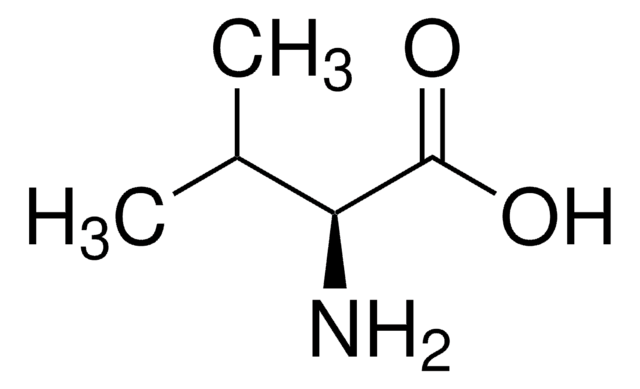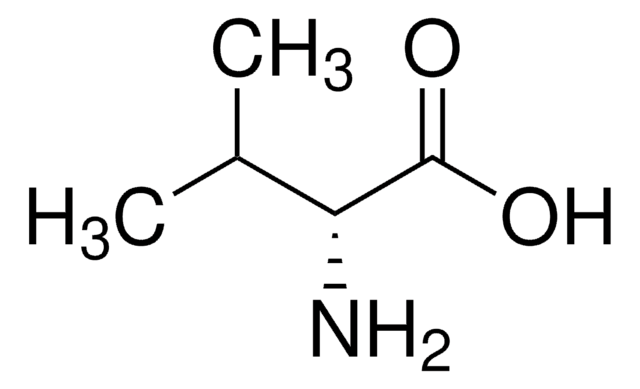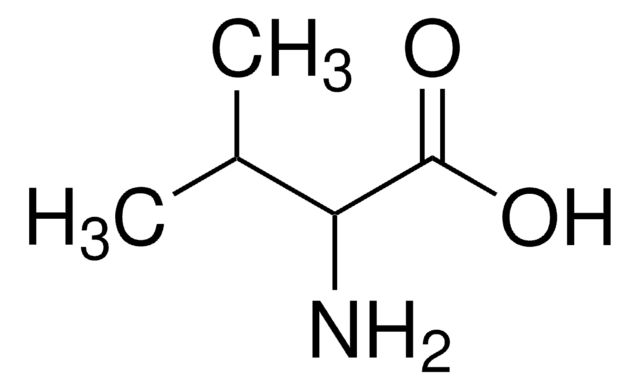94619
L-Valine
≥99.5% (NT), BioUltra
Synonym(s):
(S)-α-Aminoisovaleric acid, L-2-Amino-3-methylbutanoic acid
Sign Into View Organizational & Contract Pricing
Select a Size
All Photos(1)
Select a Size
Change View
About This Item
Linear Formula:
(CH3)2CHCH(NH2)CO2H
CAS Number:
Molecular Weight:
117.15
Beilstein:
1721136
EC Number:
MDL number:
UNSPSC Code:
12352209
eCl@ss:
32160406
PubChem Substance ID:
NACRES:
NA.26
Recommended Products
Product Name
L-Valine, BioUltra, ≥99.5% (NT)
product line
BioUltra
Quality Level
Assay
≥99.5% (NT)
form
powder or crystals
optical activity
[α]20/D +27.0±0.5°, c = 5% in 5 M HCl
impurities
insoluble matter, passes filter test
≤0.3% foreign amino acids
ign. residue
≤0.05%
loss
≤0.05% loss on drying, 20 °C (HV)
color
white
Looking for similar products? Visit Product Comparison Guide
Application
- Metabolomics reveals metabolites associated with hair follicle cycle in cashmere goats.: This study utilizes L-Valine as a standard for detecting, understanding, and enhancing hair follicle cycles in cashmere goats through metabolomic analysis, aiding in the improvement of fiber production and quality (Ma et al., 2024).
Other Notes
Protects enzymes against heat inactivation; As spacer in isotachophoresis of serum proteins; Growth requirement of various microorganisms
Storage Class Code
11 - Combustible Solids
WGK
WGK 1
Flash Point(F)
Not applicable
Flash Point(C)
Not applicable
Personal Protective Equipment
dust mask type N95 (US), Eyeshields, Gloves
Choose from one of the most recent versions:
Already Own This Product?
Find documentation for the products that you have recently purchased in the Document Library.
Customers Also Viewed
CRC Handbook of Microbiology, 4, 1-1 (1974)
T. Yagi et al. et al.
Electrophoresis ?83, 503-503 (1984)
T. Hine
Electrophoresis ?83, 541-541 null
L.G. Paleg et al.
Australian Journal of Plant Physiology, 8, 107-107 (1981)
Shankar Sachidhanandam et al.
Nature neuroscience, 16(11), 1671-1677 (2013-10-08)
Neocortical activity can evoke sensory percepts, but the cellular mechanisms remain poorly understood. We trained mice to detect single brief whisker stimuli and report perceived stimuli by licking to obtain a reward. Pharmacological inactivation and optogenetic stimulation demonstrated a causal
Our team of scientists has experience in all areas of research including Life Science, Material Science, Chemical Synthesis, Chromatography, Analytical and many others.
Contact Technical Service





